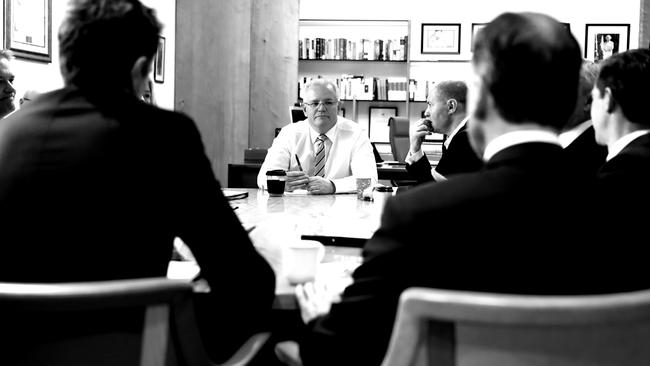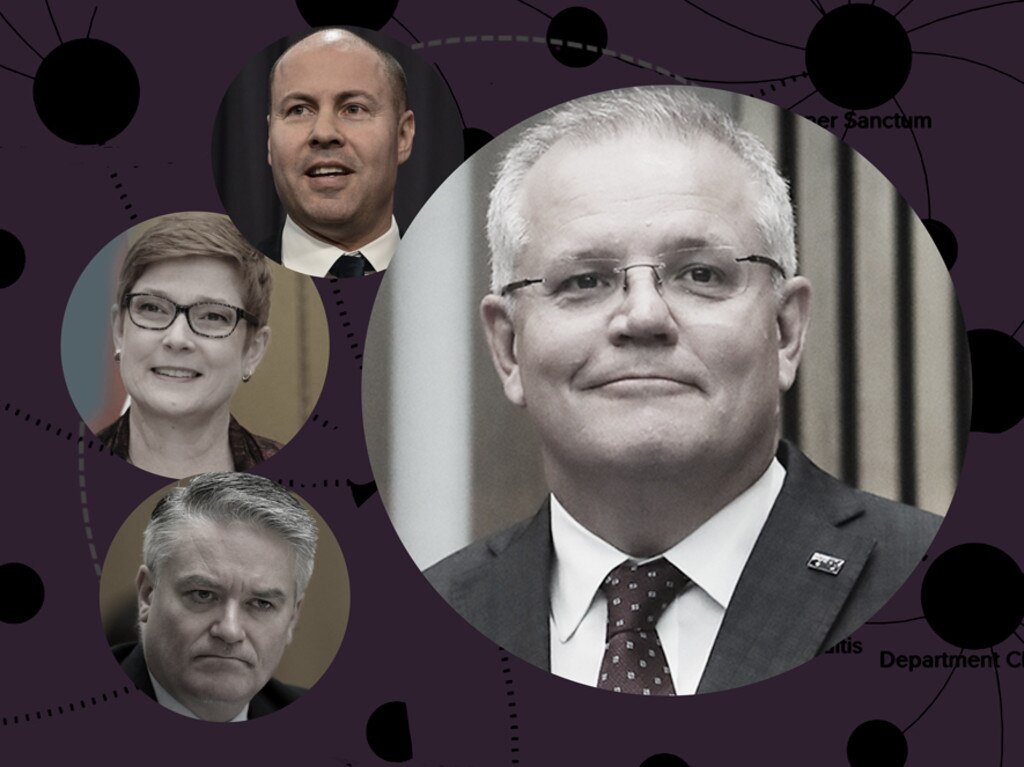The Power List: Inside Scott Morrison’s inner circle of trust
Scott Morrison has embarked on an unprecedented dismantling of power bases dominated by bureaucratic fiefdoms and the political class.

Scott Morrison has embarked on an unprecedented dismantling of power bases dominated by bureaucratic fiefdoms and the political class, in a bid to boost productivity and service delivery for Australians.
The Prime Minister has put in place a network of advisers, public service chiefs and trusted confidants to crack the “Canberra club” and deliver reforms underpinning his 2022 election agenda.
The Weekend Australian today publishes The Power List, revealing the clique of strategically linked mandarins and confidants leading generational change in the public service and tasked with delivering a radical reform plan, slashing the bureaucracy and driving key policies.
READ MORE: Inner sanctum fiercely loyal | PM’s eyes and ears | Mandarins lead PM’s reform agenda | PM’s policy shapers | Kelly: Defects in the economy | Van Onselen: PM needs to do some heavy lifting | Shanahan: Leaders to show new year’s resolution |
In buttressing his leadership with a close circle of trusted advisers, Mr Morrison has opted for experience, loyalty and performance in a power network that includes his inner sanctum, leadership group, friends, advisers, policy shapers and department chiefs.
A senior government insider said Mr Morrison had “burst the bubble” this week when he axed five department chiefs and created super departments, through a multi-phased overhaul of the public service.
The Power List: Morrison’s Network of Influence Part 1
Tap here to view Part 1 of the interactive Power List in full screen
The next phase will target more than 180 agencies and boards.
A member of Morrison’s inner sanctum, which includes Josh Frydenberg, chief of staff John Kunkel, principal private secretary Yaron Finkelstein, cabinet secretary Andrew Shearer and West Australian MP Ben Morton, described it as a very “focused” group that was based on delivery rather than “talk-fests”.
“Scott comes to the job with a very clear idea of what he wants to do … a clear judgment, and an instinct of what the politics are,” the insider said.
“It is a very tight group … it’s not a chin wag and a chat.
“It intelligently deals with issues as they rise … like drought … and while Morrison gives ministers autonomy he also gives them very clear expectations that ministers have to deliver.
“That’s how the Westminster systems are meant to work, right?”
Foreign Affairs Minister Marise Payne, the most senior woman in government, is close to the Prime Minister and is his eyes and ears on the factional warring inside the Liberal Party.
Mr Morrison retains a tight-knit group of friends and advisers, led by businessman Scott Briggs and former Liberal staffer David Gazard. Yellow Brick Road chairman Mark Bouris, Macquarie Group managing director Shemara Wikramanayake, former prime minister John Howard, political strategist Lynton Crosby, former business colleague Adrian Harrington, former NSW police commissioner Andrew Scipione, former Liberal MP Warwick Smith and developer Harry Triguboff are considered key sounding boards for Mr Morrison. His former flatmates Stuart Robert and Steve Irons, both MPs promoted by Mr Morrison, are also close to the Prime Minister.
Mr Morrison’s shake-up of the public service, the most significant since 1987, is the start of a series of overhauls aimed at streamlining the bureaucracy and making it more efficient.
A senior government source said “there is no Big Bang” but the “principles and direction have been set for people to get on board or get out”.
“Some agencies will resist, citing the need for special treatment, but they’ll more often than not find themselves in the same position as the goat which is tethered in the Tyrannosaurus Rex enclosure,” the source said.
Mr Morrison said his mission was to drive productivity through improving education, training and service delivery, and target key priority issues including mental health support, drought response and aged care. The budget, to be handed down next May, is being viewed as a key agenda-setter ahead of the next election.
“It is not just about having a resilient economy, but being able to take advantage of the potential in the economy for more productivity and for people to earn more,” Mr Morrison told The Weekend Australian.
“It’s also about a delivery of services that make a difference and that are consumer-oriented and not designed for the supplier.”
The public service shake-up, mirroring Bob Hawke’s reforms shortly after the 1987 election, is a deliberate, methodical and politically nonpartisan plan to reshape Australia’s approach to the public service, national security and the economy.
Key department chiefs who have been promoted have direct links to Mr Morrison and with each other.
They include Department of Prime Minister and Cabinet secretary Phil Gaetjens, Home Affairs boss Mike Pezzullo, Treasury secretary Steven Kennedy, Infrastructure and Transport tsar Simon Aktinson, Social Services head Kathryn Campbell, and David Fredericks, tapped to head the new Department of Industry, Energy, Science and Resources.
“These are people who can deliver; they are about action not theory,” another senior government source said.
“It has been deliberately set up, and in a nonpartisan way … not Labor, Liberal, but rather action versus inaction. These are people who will literally shape the Australian story for the foreseeable future.”
The Weekend Australian can reveal that many of the new senior mandarins have close links with Mr Morrison and personal connections through previous roles in Treasury, Defence and politics.
Mr Pezzullo, Mr Atkinson, Mr Kennedy, Mr Fredericks and Productivity Commission chairman Michael Brennan have previous experience working together. Mr Morrison worked closely with Mr Pezzullo and Chief of the Defence Force Angus Campbell in setting up and operating Operation Sovereign Borders.
Ms Campbell — a senior Army Reserves officer who worked across multiple departments — also had contact with Mr Morrison in delivering the Coalition’s major welfare reforms.
The Power List also reveals the inner workings of Mr Morrison’s office, with Dr Kunkel and Mr Finkelstein leading a team of close advisers including Mr Shearer, head of communications Andrew Carswell, Liberal Party federal director Andrew Hirst, national security adviser Michelle Chan and executive officer Nico Louw.
Insiders said Dr Kunkel, who ran Mr Howard’s cabinet policy unit before shifting to the private sector, acted as the “gatekeeper” and “decision maker”, while Mr Finkelstein took charge of “networking, speaking to stakeholders and keeping in touch with backbenchers and ministers’ offices”.




To join the conversation, please log in. Don't have an account? Register
Join the conversation, you are commenting as Logout